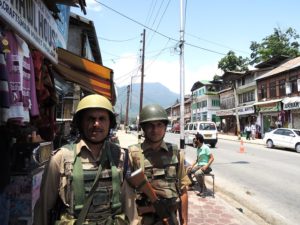
August 8, 2019: On August 6, the Indian government abolished the special status and limited autonomy Jammu and Kashmir had enjoyed since soon after India became independent. The action was generally popular in India, but was greeted with shock and anger among Kashmiri muslims and in Pakistan. This article gives you my take on this recent action.
But we also offer a look back. As many of my readers know, Howard Schaffer tracked developments in Kashmir for much of his long Foreign Service career. The account he gave of his first trip to the Kashmir valley in 1964, linked here from the Web site of the Association for Diplomatic Studies and Training, is fascinating in light of the subsequent history.
The special status was the one vestige of the goal, widely shared among Kashmiri muslims, of maintaining their separate identity rather than disappearing, as they would see it, as a tiny minority among India’s overwhelming Hindu majority. The feature of this status that affected people most directly was the restriction on land ownership to permanent residents of the state. For Pakistan, it served as a faint reminder that their claim to the state had not been forgotten by the outside world. The wider international reaction was cautious; the U.S. expressed “concern” and urged “restraint.”
The Indian government clearly anticipated trouble. Eyewitnesses report a significant increase in the security presence during the week or so before the action was taken. Essentially all communications links were cut – phone, cellphone, and internet. Local newspapers went dark. Local politicians were arrested. A curfew is still in place at this writing.
The Indian government has said that this is a strictly internal matter and that they have followed the constitutional requirements. The constitution stipulates that actions to change the state’s status must have the assent of the Jammu and Kashmir state government. The Indian government took the assent of the Governor – an appointee of the national government – as meeting this requirement; this is disputed.
Abolishing Kashmir’s limited autonomy is a longstanding goal of Indian Prime Minister Modi’s BJP party, reiterated in its manifesto during last May’s elections. The Indian government’s statements explaining its move said it was intended to “restore good governance” and improve economic development for the Kashmiris. Criticism of the state’s governance is widespread. The state has been reasonably successful in promoting human development, as measured by statistics on per capita income, literacy, and other social indicators. Investment has struggled. The uncertain security situation is certainly one of the reasons, but this action is only likely to worsen it, especially in the near term.
For those of you who would like to read about previous efforts to resolve the Kashmir issue, I recommend Howie’s book The Limits of Influence: America’s Role in Kashmir (Washington, USIP, 2009).


Tesi, Thanks, Brief but factual and useful . Good wishes.
Tezi, A very thoughtful piece amid the emotionalism, real or imagined, that has emerged. You do refer to the complex ethnic situation in Kashmir, one of the only analysts to have done so, and the varied responses to the abrogation of 3870 and 35A by these different ethnic groups. The Jammu Hindu majority has cheered it as has the Ladakhi Buddhist population. The question of course is the largely Sunni ethnically Kashmiri population of the Valley. Our President’s “offer” to mediate again underscores the virtual absence of expertise on South Asia in this government. This s a proposal (third party intervention)that both India and Pakistan rejected at Simla (1972)and later affirmed at Lahore. Walter